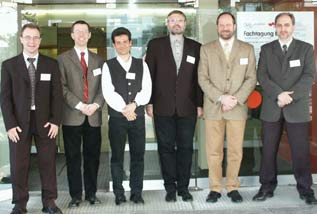Central New England
The CNE chapter held one meeting, on March 5, 2003, since the
previous Winter 2003 EMC Newsletter issue. The meeting host was
Co-Chair Boris Shusterman of EMC Corporation in Hopkinton, Massachusetts.
The speaker was Istvan Novak, Senior Staff Engineer, Sun Microsystems
Inc., Burlington, Massachusetts. His presentation described "Frequency
Domain Power Distribution Measurements." In today's advanced
digital systems, the power-distribution networks often have to
deliver hundreds of watts at low voltages, and the required low
impedance of the power distribution network must be maintained
over a wide frequency band. Traditional high-frequency measuring
instrumentation has been tailored to handle impedances close to
50 ohms. The very low impedance values in these networks create
measurement and calibration challenges. The presentation explained
the benefits of the frequency-domain method and impedance measurements
with two port Vector Network Analyzer (VNA) setups. 13 IEEE members
and 3 guests attended the meeting. As a note, out of state visitors
are welcome at our meetings that are usually held in the Corporate
Auditorium Training Center Building of EMC Corporation. We do
not have any more meetings planned prior to the Boston 2003 EMC
Symposium. Most of the Symposium steering committee members are
CNEC EMC Chapter members.
Chicago
Frank Krozel reports that the Chicago Chapter's last meeting was
in March 2003. They were lucky to have Bud Hoeft as a speaker.
Bud is a former Distinguished Lecturer of the EMC Society. Bud's
presentation, "Life Above 100 MHz" was well received
by the IEEE EMC Chapter. His intuitive approach to EMC explained
why things are sometimes not as they seem at high frequencies,
i.e. parasitic impedances. In the end, he helped the chapter members
to see that although things may seem strange above 100 MHz, they
are quantifiable and predictable. 25 members and guests were in
attendance.
France
André Berthon reports that the French Chapter held a board
meeting on February 25th. The chapter welcomes as a new board
member François de Daran from Valeo. A program of meetings
was established for 2003, starting with a meeting which will focus
on absorbing materials and near-field cartography, to be held
by mid-April.
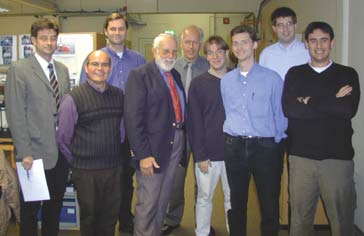 |
| Dr. Hoeft (consultant, Albuquerque,
and a prior Distinguished Lecturer of the IEEE EMC Society,
with beard) held a workshop for scientists of industry and
academia in Hamburg, hosted by Professor ter Haseborg, TUHH. |
 |
| Dr. Carl Baum gave lectures to students
and discussed his results with the research staff at the University
of Hannover and at the University of Magdeburg. |
 |
|
The 3rd workshop,
"Electromagnetic Effects," at the German Armed
Forces Institute for Protection Technology (WIS) in Munster.
International experts participated in this workshop organized
by Dr. Frank Sabath (right).
|
Germany
The German Chapter held its annual general
meeting chaired by Professor Heyno Garbe. He reported that the
German Chapter was quite busy in 2002. 20 activities took place
including technical presentations, workshops, and working group
meetings. The topics of the working groups ranged from numerical
modeling and high power EM effects to biological effects. Dr.
Frank Gronwald and Markus Heidemann received Certificates of Acknowledgement
from the EMC Society for their outstanding service to the German
Chapter. The German Chapter re-elected Heyno Garbe (University
of Hannover) as Chairman for 2003/2004. Each year at the University
of Technology Hamburg-Harburg (TUHH), special EMC lectures and
workshops take place. Professor ter Haseborg, head of the Department
of Measurement Engineering and EMC, organizes the lectures. This
year's EMC related workshop was presented by the German EMC Chapter.
Dr. L.O. Hoeft (consultant EME, Albuquerque), Distinguished Lecturer
of the IEEE EMC Society, gave an exciting presentation entitled,
"Experimental and Theoretical Analysis of Electromagnetic
Shielding of Cables and Connectors." After the presentation,
a group of experts consisting of Dr. Hoeft, members of TUHH, and
industry discussed problems concerning cable shielding as well
as special EMC measurement techniques for the detection of cable
parameters. Christoph Weber presented a new measurement set-up
for the detection of in-homogeneities in braided cable shields.
Thomas Weber presented a development in "pico TEM" technology,
addressing problems of suppression techniques of conducted UWB
pulses. More than 40 experts from research institutes and industry
met for the third workshop "Electromagnetic Effects"
at the German Armed Forces Institute for Protection Technology
(WIS) in Munster. The IEEE German EMC Chapter supported this workshop.
Professor Dr. Bernd Staginnus, head of the department, was excited
about the great turnout and positive response from the attendees.
There were participants from more than 20 international institutions
and companies. As expressed by the organizer of the workshop,
Dr. Frank Sabath, in the present age industrial countries are
highly dependent on modern information technology. All systems
used for this purpose (computers, mobiles, flight control, etc.)
are based upon electronic components. Interference to these components
by in-coupling electromagnetic fields can lead to system breakdowns
resulting in financial losses and/or danger to humans. Coupling
mechanisms, sensitivity of electronic components, and protective
measures against these threats were the major topics of this year's
workshop. In addition to the technical presentations, participants
used the time to exchange results of new theoretical and experimental
examinations and to discuss in detail questions that were raised.
Due to the overwhelming positive response to the workshop, a fourth
workshop is planed for summer 2004 at WIS Munster. At the University
of Hannover, well-known experts Dr. Carl Baum of AFRL, Kirtland,
and Dr. D.V. Giri of ProTech, Alamo, gave a presentation on "Electromagnetic
Sources and Threats to Civilian Systems." A large audience
of students and research staff were on hand. An exciting discussion
of new research results followed. In the evening, the students
enjoyed an informal dinner with the two expert researchers, talking
about technical issues as well as studying and employment in the
USA. Professor Heyno Garbe and Professor Michael Koch organized
this event for the Students Activity Program of the German EMC
Section in co-operation with the local Student Branch. Dr. Baum
also visited the Otto-von-Guericke-University Magdeburg. Two afternoons
were reserved for presentations where he explained his latest
findings on refining Impulse Radiating Antennas and constructing
efficient Narrow and Medium Band High Power Radiators. The local
EMC groups of Professor Jurgen Nitsch and Professor Gunter Wollenberg
hosted these activities. Each day, the presentations led to extended
discussions on various EMC topics. During Dr. Baum's visit, we
also organized an exciting EUROEM 2004 conference on EMC, which
will take place from July 12th to 16th 2004 in Magdeburg.
Korea
Professor Dong Il Kim (Korea Maritime University), Chairman of
the Korea EMC Chapter, reports that the Korea Chapter supported
the "2003 Technical Workshop on RF Circuit," which was
hosted by the Korea Electromagnetic Engineering Society (KEES)
at the Seoul Education Center on February 6 and 7, 2003. The papers
presented at the workshop covered the various aspects of the RF
circuit, including fundamental RF theory, design and modeling
of the high frequency active/passive element, such as LNA, MIXER,
VCO, etc. Also, the Korea Chapter plans to hold a "Workshop
on Antenna Technology" at the Seoul Education Center on April
25, 2003. This event will also be coordinated by the Korea Electromagnetic
Engineering Society (KEES).
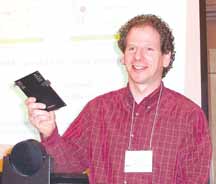 |
| Lee Hill addresses the crowd at EMC
Fest 2003 sponsored by the Milwaukee EMC Chapter. |
 |
| These colorful posters are just waiting
to take the stage for the Milwaukee EMC Chapter's EMC Fest
2003. |
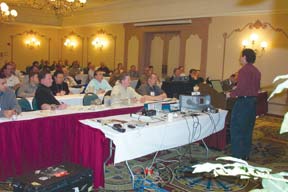 |
|
Lee Hill
brought along lots of "toys" as part of the demonstrations
conducted during his presentation. Over 70 people registered
to hear Lee's presentation in Milwaukee.
|
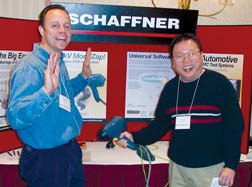 |
|
Ping Lee
of Rockwell Automation (right) dropped by the exhibits area
during the Milwaukee EMC event to demonstrate a new product.
Bill Adams of Schaffner was happy to oblige!
|
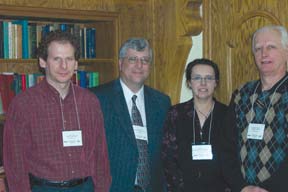 |
|
Speaker Lee Hill of Silent Solutions
joins the dynamic trio of Jim Blaha and Teresa White of
LS Compliance and Bruce Fiorani of GE Medical Systems (from
left). This trio of Milwaukee EMC Chapter members organized
their second annual one-day tutorial and exhibition for
the chapter.
|
Milwaukee
A surprise 6" snowfall couldn't stop
Lee Hill or 72 attendees and 24 exhibitors from attending EMC
Fest 2003 in Milwaukee.
This year's April 8th tutorial focused on "Applied Electromagnetic
Compatibility for PC Board and System Design." Mr. Lee Hill
of Silent Solutions, LLC kept the audience involved by his unique
style of "teaching through example." After the introduction
of a key concept or topic, Lee followed with an everyday, hands-on
example that reinforced the lecture material. This style of presentation
led to this comment from one of the EMC Fest survey forms: "Lee
Hill is excellent." Jim Blaha, Milwaukee EMC Chapter Chair,
also acted as the Technical Program Chair. Jim has set a goal
for the Milwaukee EMC Chapter to bring "value" to having
an IEEE membership. Focusing on educational programs that are
local and affordable brings an "Educational Value" to
all IEEE members and non-members. One outcome of this goal may
be summarized by another comment from an EMC Fest survey: "One
the best I have attended." EMC Fest 2004 is already under
development. The goal of bringing value to IEEE membership and
educational value to all involved with EMC will remain the chapter's
objective.
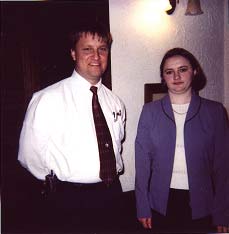 |
| Mohawk Valley EMC/Reliability
Chapter Chair Irina Kasperovich welcomes guest speaker Dr.
Alan Lindsey. |
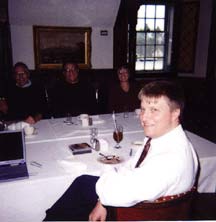 |
| Dr. Alan Lindsey Conducts a round
table discussion of his Transmission Hypercube Concept for
Efficient Spectrum Utilization. |
Mohawk Valley
The Mohawk Valley Joint EMC/Reliability Chapter
hosted a meeting on 20 March 2003. The focus of the meeting was
on the topic of signal waveform diversity and its impact on EMC
and spectrum management. Guest speaker Dr. Alan R. Lindsey, P.E.
of the Air Force Research Laboratory/IFGC, Rome Research Site
gave a super presentation titled, "Multiobjective Joint Optimization
of the Radio Frequency Transmission Space", which addressed
the issue of dimensional inefficiency in utilization of the RF
transmission space. In his words, "We spend a lot of time
thinking about bandwidth efficiency (i.e., maximizing the bits/sec/Hz),
but an approach to optimally integrated full signal space dimensionality
will be required to support the orders of magnitude increases
necessary to sustain even the next 5 to 10 years of demand explosion
in wireless devices and applications." The current track
of thought on what constitutes signal transmission space is primarily
focused on the frequency domain.
Dr. Lindsey's view is that the "spectrum crisis" is,
in fact, no crisis at all, but this is entirely due to the fact
that there is no identifiable path toward optimal utilization
of the entire transmission space. He envisions a scheme in which
there are at least four, possibly five or more dimensions in the
RF resource (transmission) space available. For instance, there
is time and geographic space and code (modulation). Polarization
can be considered yet another possible dimension. According to
Dr. Lindsey, while there is a bevy of technology that capitalizes
on these individually, there is virtually nothing that integrates
these dimensions and optimally allocates a range in the N-tuple
for maximal throughput across the entire user base. Adaptivity,
agility, mobility, flexibility, free "market" - These
are the enabling words for future wireless expansion, not to mention
the solution to the specific problem of military radio interoperability
and software radios in general. From this perspective it is desired
to formalize the concept, perform modeling and simulation, and
demonstrate a feasible and practical algorithm jointly optimizing
the utilization of RF resources with respect to multiple objectives
to include (but not limited to) battery consumption, required
output power, antenna efficiency, throughput, source-to-sink latency,
bandwidth efficiency, spatial localization, etc. Dr. Lindsey's
vision is that of a brokered or centrally managed agent which
accepts requests for transmission space hypercubes from systems
desiring to transmit electromagnetic energy, and outputs a simple
pair of coordinates in N-space (N being the number of dimensions
in the transmission "space") that bound a hypercube
which the transmitter is authorized to occupy. Once the transmission
is complete (time range fulfilled) the transmission ends and another
user is given coordinates for the next transmission. The agent
optimally "fills" the space with hypercubes to minimize
unused RF resources while simultaneously optimizing the physical
constraints of the participating systems, according to user-defined
priorities.
Dr. Lindsey is currently responsible for basic
research in interference mitigation for spread spectrum communication
systems, computationally feasible trellis-based channel coding
in high dimensional signal spaces, wavelet packet modulation,
and efficient transform algorithms. We anticipate his ongoing
contributions in these areas will be of interest to the EMC Society's
TC-6 Committee on Spectrum Management.
On another note, Chair Irina Kasperovich was recently recognized
by the Mohawk Valley Engineers Executive Council (MVEEC) for her
efforts to rejuvenate the Joint EMC/Reliability Chapter within
the IEEE Mohawk Valley Section, and making use of the Distinguished
Lecturer Program and Angel funding opportunities for the benefit
of the local technical community. The award was conferred at the
53rd Annual Engineer's Week Awards Banquet sponsored by the MVEEC.
The MVEEC is a professional organization whose members represent
various other professional/technical societies and institutes
such as the IEEE.
 |
| Dr. Keith Harding, EMC
Society Distinguished Lecturer, of Lexmark Corporation, was
the speaker at the January meeting of the Orange County EMC
Chapter. He drew attendees from as far away as San Diego (90
minutes south of the meeting location in Brea)! |
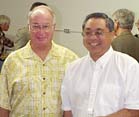 |
| W. Michael King, consultant,
and Ed Nakauchi, Laird Technologies, of the Orange County
EMC Chapter. They attended the January Chapter meeting held
at CKC Labs in Brea, California. |
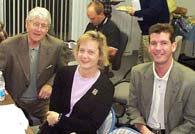 |
| Orange County EMC Chapter members
Derek and Steve McNally of DJM Electronics (left and right)
flank guest Janet O'Neil of ETS-Lindgren during dinner at
the January chapter meeting. |
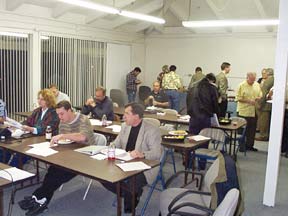 |
| The Orange County EMC Chapter regularly
starts its meeting with an informal buffet dinner that is
free for all attendees. |
Orange County
On January 16, the Orange County EMC Chapter
welcomed Dr. Keith B. Hardin of Lexmark Corporation. Dr. Hardin,
an EMC Society Distinguished Lecturer, provided a presentation
on "Two Layer PCB EMC Design Techniques" that was very
well received by the audience of over 30 local engineers. The
presentation included information on Circuit Design Considerations,
Effect of Frequency and Duty Cycle, History of Controlling the
Source Spectrum, Design for Multiple Frequencies, etc. Dr. Hardin
showed how many products can use a two layer PCB instead of a
four or more layer design. The presention was very informative
and the audience stayed more than 40 minutes after the conclusion
to ask questions. The presentaion by Dr. Hardin was a great start
for the Orange County Chaper for the year 2003. Incidentally,
some guests present at the meeting had attended the presentation
given by Dr. Hardin to the San Diego EMC Chapter the night before.
They enjoyed his presentation so much that they made a three-hour
round trip drive from San Diego to Orange County so they could
hear him speak two nights in a row! The Orange County Chapter
is sponsoring a one-day tutorial on June 12, 2003. The tutorial,
called "EMC Fest '03," will feature speakers W. Michael
King and Douglas C. Smith. So, mark your calendars. You don't
want to miss this one! For more information, please contact the
Chapter Vice Chair, Randy Flinders, at (714) 513-8012, or at rflinders@ieee.org.
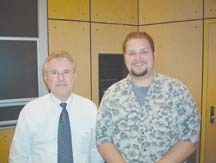 |
| Dennis King and Derick Skouby at
the Oregon and SW Washington meeting on January 29. |
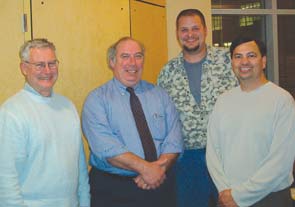 |
| Dan Hoolihan, Bruce Archambeault,
Derick Skouby and Henry Benitez (from left to right) attended
the Oregon and SW Washington Chapter meeting on February 26. |
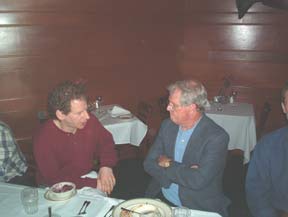 |
|
Speakers
Lee Hill and Tom Van Doren at dinner following the EMC Northwest
Colloquium on March 24 organized by the Oregon and SW Washington
Chapter.
|
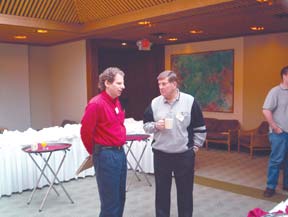 |
|
Lee Hill
and Don Zalezky are shown during a break at the EMC Northwest
Colloquium on March 24.
|
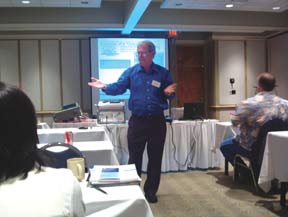 |
|
Tom Van Doren
gave a lively presentation at the EMC Northwest Colloquium
on March 24.
|
Oregon and SW Washington
David Britton, the Vice Chair of the Oregon and SW Washington
chapter, reports that they held a meeting on January 29th at the
University of Portland. Dennis King from FerriShield gave a presentation
on "The Future of Ferrite." The dinner and meeting were
well attended. On February 26th, Distinguished Lecturer and EMCS
Board Member Bruce Archambeault presented "The Ground Myth"
at the chapter meeting. Attendance exceeded capacity at this event.
EMCS Board Members Dan Hoolihan and Henry Benitez were also in
attendance. The chapter hosted the one day EMC Northwest Colloquium
on March 24th. Dr. Tom Van Doren from the University of Missouri
- Rolla and Lee Hill of Silent Solutions LLC were present as speakers.
The event was very successful with nearly 100 in attendance. 18
vendors helped make this event a smashing success! The chapter
has scheduled Bruce Harlacher of Fischer Custom Communications
as the April 30th speaker and he will present "CISPR 22:
Radiated and Conducted Emissions Testing for Information Technology
Equipment." Additionally, Bruce will provide an update on
"What's Happening with the 4th Edition of CISPR 22."
On May 21st, the chapter has scheduled Cheung-Wei Lam of Apple
Computer as the speaker and he will present "Signal Integrity
Design versus Radiated Emission Control." Details of the
Oregon and SW Washington Chapter activities can be found on the
website: https://www.worldaccessnet.com/~emc/
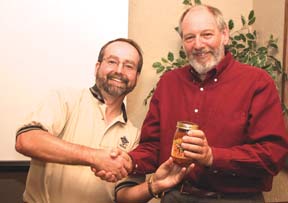 |
|
Phoenix Chapter
Chair Harry Gaul presents speaker Dr. Stringfellow with
a jar of Gunslinger Hot Salsa in appreciation of his talk
on lightning electromagnetic field effects on buildings.
|
Phoenix
Glen Gassaway reports that the February 27th meeting was well
attended; The Embassy Suites Tempe/Garcia's Mexican Restaurant
meeting room was nearly at capacity. It was great to see such
attendance! Dr. Mike Stringfellow of PowerCET presented his latest
measurements of lightning electric and magnetic fields and ground
grid currents inside buildings of different construction, including
a shielded computer room as well as a brick building. He also
discussed possible shielding techniques to minimize these fields
or their effects. It is estimated that lightning damage in the
US exceeds $1 billion per year, where at least half of these losses
are due to indirect effects. For computers, power supply damage
is unlikely because of the abundance of transient suppressors
in computer power supplies. Damage is far more likely to communications
ports, especially RS-232 serial ports. Lightning striking the
ground up to a few hundred meters from a facility will create
strong electric and magnetic fields. These fields may penetrate
the structure directly or may induce currents on the building
itself that in turn produces fields inside it. The fields inside
the building can induce currents on communication and data lines,
which may be large enough to cause damage or disruption to systems.
The currents induced on the building also flow into the ground
electrodes of the structure unequally, resulting in transient
equalization currents in the ground grid. Dr. Stringfellow's measurements
demonstrated that the reduction of a lightning-induced magnetic
field in the interior a brick building is only about 2% lower
than the external intensity! Lightning shielded rooms, although
better, were still not perfect. About 30% of the external H-Field
intensity was observed internally. Hardening principles may include
the application of a reasonable Faraday cage in the room design,
surge suppression, shielding, and perhaps an upgrade of the communications
media away from RS-232. Dr. Stringfellow's presentation slides
as well as information on upcoming meetings is available at the
chapter's web site, https://www.ewh.ieee.org/r6/phoenix/phoenixemc/.
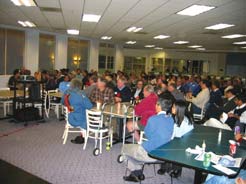 |
| Attendees at the Santa Clara Valley
EMC Chapter Meeting in December 2002. |
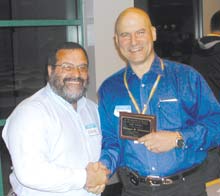 |
| Santa Clara Valley Chapter Chair
Tom Cokenias (right) gives the helm over to incoming chair
Chuck Troia (left). |
Santa Clara Valley
Darryl Ray reports 37 members attended the October 2002 meeting
held at a new venue: Applied Materials Corporation in Santa Clara.
After the customary dinner and social, a report from the 2004
Symposium Committee Chair was given. The balance of the meeting
was an open forum or "Town Hall Meeting" intended to
solicit input from the membership. The open forum promoted interaction
and discussion about useful topics for technical sessions to be
held during the 2002-2003 season. Jeff Evans (former Chapter Chair)
was presented with a small gift and some words of thanks by Darryl
Ray. Jeff has taken a new position at Hewlett Packard in Roseville,
CA that deals with power supply design. Now Jeff can create lots
of interference that he spent many years fixing! In November,
67 people attended the meeting to hear Stu Kron of Sunol Sciences
give a presentation on EMC antennas. Stu provided us with a glimpse
into the background, design and construction of the EMC antennas
many of us presently use. Stu's talk was very well received, and
we've asked him to present to us again at a later date. In December,
the chapter held its annual joint meeting with the Santa Clara
IEEE Safety Society. The chapter provided food and drink to celebrate
the upcoming holidays. The chapter had four candidates to run
for the position of secretary. Ton Winegar was voted in for new
secretary starting January 2003. Dr. M. Meyyappan, the IEEE Distinguished
Lecturer for the IEEE Nanotechnology Council, gave a presentation.
He is the Director of the Center for Nanotechnology at NASA Ames
Research Center in Moffett Field, California. His talk presented
an overview of novel nanoelectronics concepts based on carbon
nanotubes (CNTs) and molecular electronics, nanosensors and detectors,
nanoelectromechanical systems (NEMS), nanoscale materials and
fabrication techniques. His presentation was very stimulating
and based on a subject new to most of the 128 attendees. The Q&A
session lasted for over 30 minutes, and the evening was a very
satisfactory close for the 2002 season. As of January 1, the new
chapter officers are: Chair: Chuck Troia, Vice Chair: Len Goldschmidt,
Treasurer: Bertram K.C. Chan and Secretary: Tom Winegar. In January,
Robert Dahlgren, president of Silicon Valley Photonics Ltd, discussed
emissions from optical fiber cable connectors. He addressed the
conventional wisdom that that optical fiber is dielectric, and
thus does not radiate RF emissions. In reality however, these
devices have some amounts of conductive material (for example
a ferrule, spring, and crimp ring) and thus have an affect on
radiated emissions. As data rates have increased beyond 1 gigabit/second
(Gbps) the emissions challenges are increasing. 54 people attended.
The February 11 meeting featured Lee Ritchey, owner of Speeding
Edge, a consulting firm. Mr. Ritchey spoke on the topic of Vcc
and Ground Bounce in planes and IC packages and how it may be
the cause of radiated and conducted emission problems from the
enclosure and cables. 76 people attended the meeting. In March
54 people attended a presentation by Chuck Oleson, owner of Oleson
Microwave Labs, Morgan Hill, California. Chuck spoke about recent
advances in Millimeter Wave equipment at frequencies up to 230
GHz! Performance characteristics of various spectrum analyzers
and mixers were reviewed. The chapter also is working very hard
on the upcoming 2004 EMC symposium in Santa Clara. Monthly steering
committee meetings are held at Apple Computer in Cupertino, California.
Stay tuned for further details on the 2004 Symposium.
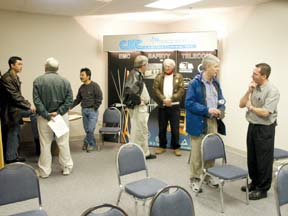 |
| Seattle EMC Chapter members network
following the January chapter meeting held at CKC Labs in
Redmond. |
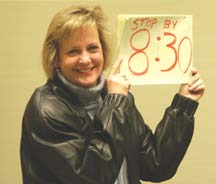 |
|
While Dr. Archambeault's presentation
was interesting, the Seattle Chapter Chair felt an obligation
to get the chapter members home at a reasonable hour!
|
 |
| Over 70 people attended the February
Seattle EMC Chapter meeting held at Microsoft in Redmond.
Dr. Bruce Archambeault was the speaker on the hot topic: "Effective
Power/Ground Plane Decoupling for PCBs." |
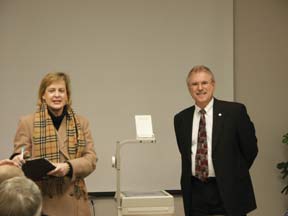 |
| Janet O'Neil introduces speaker Dennis
King of FerriShield at the January meeting of the Seattle
EMC Chapter. |
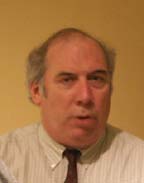 |
| The Seattle EMC Chapter was privileged
to be the first chapter to feature Dr. Archambeault in his
capacity as a newly appointed Distinguished Lecturer. |
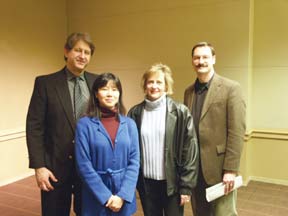 |
| The Seattle EMC Chapter Officers
congregated after the great meeting with Dr. Archambeault.
Shown left to right are Mark Chase of CKC Labs, Secretary,
Kitty Tam of Microsoft, Treasurer, Janet O'Neil of ETS-Lindgren,
Chair, and Pat André of André Consulting, Vice-Chair. |
 |
|
Tom Moyer
of AR/Kalmus was the first speaker at the Seattle Chapter's
March "Double-Header" meeting. He prepares to
set up his demo of BCI testing with the encouragement of
Chapter Chair Janet O'Neil.
|
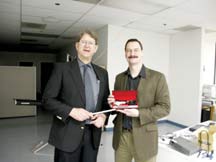 |
| The March Seattle EMC Chapter meeting
featured the tag team of Pat André and Mark Chase on
"Common EMI Problems and How to Troubleshoot Them." |
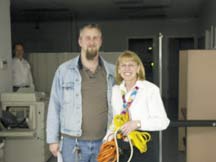 |
|
Seattle EMC
Chapter member Steve Anderson of Alpha Technologies assisted
Jeannie Olson of AR/Kalmus in picking up following the March
chapter meeting held at her facility in Bothell.
|
Seattle
At its January 2003 meeting, the Seattle EMC Chapter featured
"The Future of Ferrite" as presented by Dennis D. King
of FerriShield. This meeting was held at CKC Labs in Redmond.
Some 25 people attended. Mr. King showed how the use of ferrites
has been applied to several new EMI disciplines, specifically
custom materials and products for Bluetooth and WiLAN applications,
and custom products for EMI suppression on unique replacements
for traditional wire and cable harnesses. Mr. King's company has
been producing custom parts for X2Y Attenuators, LLC and some
of those results were discussed in this meeting. In February,
the attendance record for a Seattle EMC Chapter meeting was broken
as 73 people attended the meeting! This is a new, all time high
attendance record! Folks came to hear Dr. Bruce Archambeault,
IEEE EMC Society Distinguished Lecturer, speak on the topic "Effective
Power/Ground Plane Decoupling for PCBs." This meeting was
held at Microsoft who generously provided free pizza and beer
for the social hour before the presentation. Decoupling of power
and ground-reference planes is an important issue for both EMI
emissions control and for circuit functionality. This topic has
generated many technical papers, and controversy. While there
has been a lot of attention on this topic, there is still significant
confusion about the best strategy for decoupling. Dr. Archambeault's
talk focused on the sources of noise that the decoupling capacitors
are intended to control, and the physics involved in the noise
propagation, and how to properly analyze the decoupling capacitor
performance. The analysis must be performed in BOTH the time domain
and the frequency domain. The frequency domain analysis is a steady
state analysis, and will determine resonances, which are most
useful for EMI emissions analysis. The time-domain analysis is
a transient analysis and will help determine how well the current
is delivered to the IC, and ultimately, how large (or small) the
generated noise pulse will become. Real-world examples of measurements,
as well as computer simulations, were used to demonstrate the
optimal decoupling strategy. Dr. Bruce Archambeault is a Senior
Technical Staff Member at IBM in Research Triangle Park, NC. He
received his Ph. D. from the University of New Hampshire in 1997.
His doctoral research was in the area of computational electromagnetics
applied to real-world EMC problems. He is the author of the book
"PCB Design for Real-World EMI Control" and the lead
author of the book titled "EMI/EMC Computational Modeling
Handbook." In March, in keeping with the start of baseball
season, the chapter featured a double-header meeting! Speakers
included Thomas C. Moyer of Amplifier Research on "RF Conducted
Immunity Testing" and the tag team of Mark Chase of CKC Labs
with Pat André of André Consulting, Inc. on "Common
EMI Problems and How to Troubleshoot Them." The meeting was
scheduled from 4-8 pm at AR/Kalmus in Bothell. Tom Moyer explained
that RF conducted immunity testing is one of the most difficult
tests for the EMC engineer to implement. This is true because
the IEC 61000-4-6 specification is difficult to comprehend and
it uses terminology that is not entirely familiar to the US engineer.
Often the RF conducted immunity test has to be performed using
bulk current injection (BCI) for CE marking, telecom and automotive
testing. The BCI test adds more complexity to the RF conducted
immunity test because great care must be taken to avoid over injection
of current. Over injection of current during this test can lead
to EUT failures that are bogus resulting in possible erroneous
rejection of otherwise good products. Tom covered the requirements
of the IEC RF conducted immunity specifications and provided a
demonstration of BCI testing. The audience learned that Tom worked
for Ford Motor Company designing automotive electronics systems
and for Ametek U. S. Gauge designing aircraft engine instruments
before joining Amplifier Research in 1996 as a product line-marketing
specialist. In between presentations, Texas Smokehouse BBQ catered
a buffet dinner. Next, Pat André and Mark Chase took the
stage and shared a variety of equations, design, and troubleshooting
techniques. These included impedance equations, wavelength calculations,
case shielding and design considerations, and even how to wind
a balun. Examples from actual situations were presented. A short
question and answer period followed the presentation. This presentation
by Seattle EMC Chapter officers Pat and Mark was practical, educational,
and entertaining as well! Chapter members learned that Pat André
is NARTE Certified as both an EMC Engineer and as an ESD Engineer.
He has worked in the military and aerospace environment for the
entire 19 years, and worked in the commercial electronics environment
for the last seven. Pat has a strong ability in the test and measurement
area of EMC. He is president of André Consulting, Incorporated.
Pat also works for the Seattle Gilbert and Sullivan Society as
the Sound Designer. But, all in all, he would rather be golfing.
Mark Chase is currently a Senior EMC Engineer at CKC Labs in Redmond.
He has published and presented several papers at the IEEE EMC
Society annual symposia. Before joining CKC Labs in 1998, he was
with Hewlett Packard in Vancouver, Washington for eight years
where he worked in Bob Dockey's famous EMC lab. Much of his expertise
is in troubleshooting and near field probe design. But, all in
all, he would rather be back on stage playing guitar.
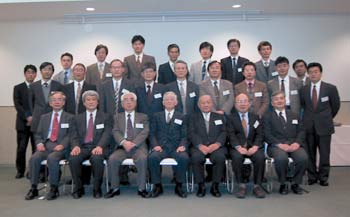 |
| Sendai Chapter members attended the
chapter initiation ceremony. |
Sendai, Japan
The Sendai Chapter, which is located in the birthplace of Japanese
EMC research, held a ceremony celebrating the chapter's establishment.
Thirteen members joined the ceremony with many honored guests
from the EMC Tokyo Chapter and the IEEE Sendai Section. A buffet
party celebrating that Professor Risaburo Sato received the Richard
R. Stoddard Award from the EMC Society followed the ceremony.
You can visit the Chapter's web page to see the photo album of
the meeting at www.topic.ad.jp/emc-sendai/.
In addition, the Sendai Chapter held two more research and technical
meetings in the year of 2002. Chapter members are currently making
preparations for the 2004 EMC International Symposium in Sendai
on June 1-4, 2004. EMC
 Chapter
Chatter
Chapter
Chatter 